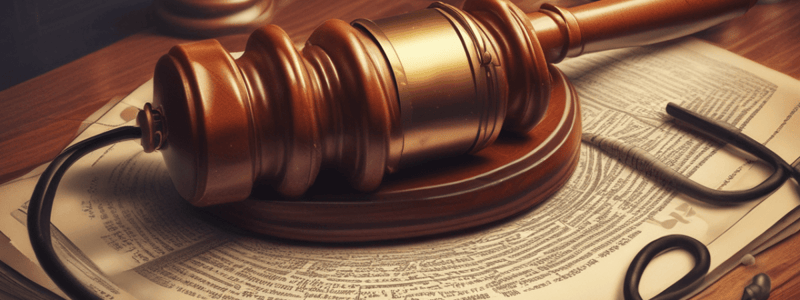Podcast
Questions and Answers
What is the main focus of the intrusion into seclusion tort?
What is the main focus of the intrusion into seclusion tort?
- Safeguarding an individual's private affairs from intentional intrusion (correct)
- Preventing individuals from spying on their neighbors
- Protecting sensitive information from cyber theft
- Ensuring government transparency in public dealings
When did the concept of intrusion into seclusion as a tort begin to take shape?
When did the concept of intrusion into seclusion as a tort begin to take shape?
- Mid-20th century
- Late 15th century
- Around the turn of the 20th century (correct)
- Early 19th century
Which influential paper contributed significantly to the development of the intrusion into seclusion tort?
Which influential paper contributed significantly to the development of the intrusion into seclusion tort?
- Legal Rights and Personal Freedom, 1910
- The Right to Privacy Act, 1880
- The Right to Be Left Alone, 1875
- The Right to Privacy, 1890 (correct)
Which state was the first to formally adopt the intrusion into seclusion tort?
Which state was the first to formally adopt the intrusion into seclusion tort?
What is a key requirement for plaintiffs to establish an intrusion into seclusion claim?
What is a key requirement for plaintiffs to establish an intrusion into seclusion claim?
Apart from physical intrusion, what other method can be considered for the intrusion into seclusion tort?
Apart from physical intrusion, what other method can be considered for the intrusion into seclusion tort?
Which of the following is NOT a required element for an intrusion into seclusion claim?
Which of the following is NOT a required element for an intrusion into seclusion claim?
Which of the following factors is NOT considered when determining if an intrusion is highly offensive to a reasonable person?
Which of the following factors is NOT considered when determining if an intrusion is highly offensive to a reasonable person?
Which type of damages is NOT typically available for a successful intrusion into seclusion claim?
Which type of damages is NOT typically available for a successful intrusion into seclusion claim?
Which of the following statements about the intrusion into seclusion tort is NOT true?
Which of the following statements about the intrusion into seclusion tort is NOT true?
Which of the following statements best describes the purpose of punitive damages in intrusion into seclusion cases?
Which of the following statements best describes the purpose of punitive damages in intrusion into seclusion cases?
Which of the following statements is true regarding the types of damages awarded in intrusion into seclusion cases?
Which of the following statements is true regarding the types of damages awarded in intrusion into seclusion cases?
Flashcards are hidden until you start studying
Study Notes
Introduction
Privacy tort law encompasses various types of harms that violate the individual's rights to privacy. Among these torts is the intrusion into seclusion, a type of invasion of privacy that occurs when someone intentionally intrudes upon a person's private affairs or concerns, creating an atmosphere of embarrassment or shame. This article discusses the specifics of the intrusion into seclusion tort, including its history, elements, and potential damages.
History of the Tort
As a relatively modern development in privacy law, the intrusion into seclusion tort traces its origins to the late 19th and early 20th centuries. The concept began to take shape around the turn of the century, with influential works like Samuel D. Warren and Louis Brandeis' groundbreaking paper, "The Right to Privacy," published in 1890. Over time, the idea evolved into a formal legal doctrine, with the first state to formally adopt it being Georgia in 1905. Today, the majority of states recognize the intrusion into seclusion tort as a valid basis for liability and damages, having established it either through legislation or judicial interpretation.
Elements of the Tort
To establish an intrusion into seclusion claim, plaintiffs must demonstrate several essential components:
-
Intentional intrusion: The intrusion must be deliberate and purposeful, rather than accidental or incidental. This can involve physical or electronic surveillance, among other methods.
-
Seclusion or privacy: The location or subject matter of the intrusion must be considered secluded or private, meaning it is expected that one's privacy will be respected in these situations.
-
Without permission: The intrusion must occur without the victim's consent or authorization.
-
Highly offensive to a reasonable person: The intrusion must be offensive to the ordinary reasonable person, taking into account the degree of intrusion, context, and surrounding circumstances, including the intruder's motives.
Damages and Remedies
The damages available for a successful intrusion into seclusion claim can include emotional distress, injury to reputation, and, in some cases, punitive damages to punish the defendant for their actions and deter similar conduct in the future. The specific types of damages awarded may vary depending on the jurisdiction and the facts of the case.
Conclusion
The intrusion into seclusion tort represents a significant stride forward in protecting individuals' privacy rights by providing legal recourse against unauthorized invasions that undermine personal dignity and autonomy. As technological advancements continue to blur the lines between public and private spaces, the importance of this tort becomes even more evident.
Studying That Suits You
Use AI to generate personalized quizzes and flashcards to suit your learning preferences.



